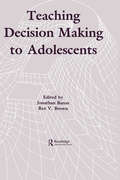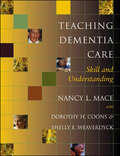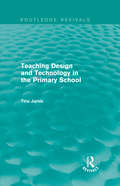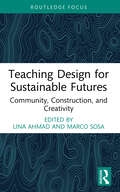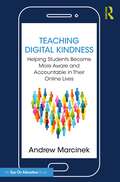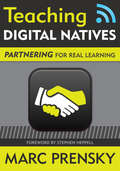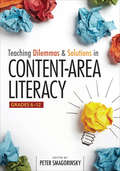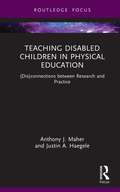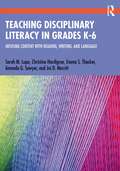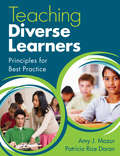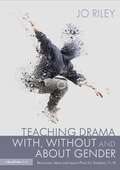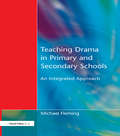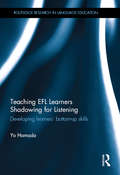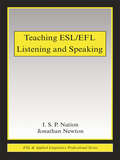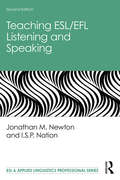- Table View
- List View
Teaching Decision Making To Adolescents
by Jonathan Baron Rex V. BrownThis book describes a variety of programs -- firmly based in psychological theory and modern decision analysis -- that are suitable for teaching adolescents how to improve both their own decision making skills and their understanding of the decision making of others. Providing practical advice as well as theoretical analysis, this volume addresses general questions such as the nature and rationale of the enterprise, its implementation, and its evaluation. Relevant to several current adolescent problems including drug abuse, this is an excellent source, either as research, new curriculum, or enrichment of old curriculum.
Teaching Dementia Care: Skill and Understanding
by Nancy L. MaceDementia afflicts millions of Americans and deeply affects the lives of their loved ones. Good care has been proven to have a significant effect on the quality of life of a person with dementia. To ensure good care, staff members of nursing homes, assisted living facilities, and adult day-care centers, and providers of home care must be thoroughly and continually trained by qualified and well-prepared professionals.Nancy L. Mace, coauthor of The 36-Hour Day, has created the ultimate teachers' guide for dementia care training. Rich with information and with tools for effective communication between teacher and student, the text supplies instructors with in-depth lessons and includes relevant charts, tables, and handouts, which may be customized to suit specific programs. Good training is the foundation for a confident and competent caregiver and supports the dignity and well-being of persons with dementia and their families. With her unmistakable compassion, humor, and wisdom, Mace has provided a much-needed guidebook for better teaching and better care.
Teaching Democracy in an Age of Uncertainty: Place-Responsive Learning (Routledge International Studies in the Philosophy of Education)
by Gilbert Burgh Simone ThorntonThe strength of democracy lies in its ability to self-correct, to solve problems and adapt to new challenges. However, increased volatility, resulting from multiple crises on multiple fronts – humanitarian, financial, and environmental – is testing this ability. By offering a new framework for democratic education, Teaching Democracy in an Age of Uncertainty begins a dialogue with education professionals towards the reconstruction of education and by extension our social, cultural and political institutions. This book is the first monograph on philosophy with children to focus on democratic education. The book examines the ways in which education can either perpetuate or disrupt harmful social and political practices and narratives at the classroom level. It is a rethinking of civics and citizenship education as place-responsive learning aimed at understanding and improving human-environment relations to not only face an uncertain world, but also to face the inevitable challenges of democratic disagreement beyond merely promoting pluralism, tolerance and agreement. When viewed as a way of life democracy becomes both a goal and a teaching method for developing civic literacy to enable students to articulate and apprehend more than just the predominant political narrative, but to reshape it. This book will be of interest to scholars of philosophy, political science, education, democratic theory, civics and citizenship studies, and peace education research.
Teaching Design and Technology 3 - 11
by Douglas Newton'Douglas Newton's Teaching Design and Technology gives encouragement to creativity in younger pupils. Aimed at ages 3-11, it contains a variety of suggestions for activities providing more than just a collection of ideas, there are many suggestions that might help children plan and work towards quality products' - The Times Educational Supplement 'An excellent book which is both thought-provoking and extremely practical. The philosophy and history behind D&T is enlightening and very entertaining, whilst the numerous ideas for practical activities make it a 'pick up and use' book. Unusually, it provides a wide range of activities for children as young as 3 up to 11 years of age, and detailed lesson plans demonstrate how they can be presented in class. The problem-solving approach taken by this book supports views on 'best practice' as described in the government publication 'Excellence and Enjoyment'. As the focus in education is on developing a more creative curriculum, this book is a must for both experienced teachers and students alike' - Linda Johnston, Head at Sedgefield Hardwick Primary 'This book is packed full of sound advice and good ideas interlaced with the essence of what Design and Technology in primary schools should be' - David Jinks, Jerwood Laureate 'A very practical book, which focuses on sound advice from an expert in D&T education... Here you will find a wealth of ideas for putting into practice. What shines through is the depth of experience that Newton brings to the work... This is an invaluable resource for any primary school and deserves to be widely read. I have no doubt that teachers will rate it highly' - Primary Science Review 'This very readable book gives a wealth of simple interesting examples of technological development that will be appreciated by children throughout the primary school... Very practical general teaching advice is given throughout... a valuable resource for trainees and teachers who lack experience in this subject' - Journal of Education for Teaching Training to teach Design and Technology? Need ideas for your lessons? Want to refresh your D&T teaching? Professor Douglas Newton's succinct guide to teaching design and technology uses ideas that have been road-tested and developed over his many years of teaching and of training student teachers and practitioners. Assuming no prior knowledge, this straightforward book will quickly help you teach D&T in the primary school and D&T-related activities in the very early years. It gives you ready-made lesson plans and banks of teaching ideas for immediate use in your classroom. Written for the busy trainee and teacher, this practical book features: - A clear account of the nature of D&T and what is expected of you. - Time-saving, photocopiable worksheets to help children grasp problems, develop ideas and plan. - Lots of activities for the children, some set out in step-by-step detail. - Advice on helping children make progress and on assessing their work. - Looking ahead: some guidance for the aspiring teacher on preparing for curriculum leadership. - Helpful chapter summaries.
Teaching Design and Technology Creatively (Learning to Teach in the Primary School Series)
by Clare Benson Suzanne LawsonPacked full of practical ideas, Teaching Design and Technology Creatively is a stimulating source of guidance for busy trainee and practising teachers. Grounded in the latest research, it offers a wealth of suggestions to foster creative development in D&T and supports teachers in providing their students with more authentic, enjoyable experiences. Providing a wealth of ready-to-use ideas for creative lessons, key topics covered include: Understanding links between D&T and creativity Creating a foundation for D&T in the early years Using objects, books and real-life contexts as imaginative starting points Developing designerly thinking Making the most of construction kits Helping children draw to develop their ideas Encouraging dialogic talk in D&T to drive learning Exploring food as a creative resource Practical approaches to embedding IT and programming in the curriculum Taking learning outside the classroom. Teaching Design and Technology Creatively provides practical teaching suggestions to ensure teachers of all levels understand how to teach for creativity. It shows how learning experiences in D&T have the potential to extend children’s technological knowledge, and to promote problem-solving and evaluation skills. Drawing on examples from real-world projects, this text is invaluable for all those who wish to engage students in D&T and encourage creative classroom practice.
Teaching Design and Technology in the Primary School (Routledge Revivals)
by Tina JarvisOriginally published in 1993. The appearance of design and technology in the National Curriculum has offered primary teachers opportunities for imaginative and stimulating work which is directly related to the lives of their pupils. Its sheer scope can, however, be daunting for the teacher already overloaded with the other demands of the National Curriculum. Tina Jarvis provides some much needed guidance on strategies for including design and technology effectively within the whole curriculum, including the development of co-operative group-work and finding effective ways to assess individuals in group situations. The author also looks at how teachers can tackle subject areas which may be unfamiliar to them, such as systems, environments and economic enterprises.
Teaching Design for Sustainable Futures: Community, Construction, and Creativity (Routledge Focus on Design Pedagogy)
by Lina Ahmad and Marco SosaTeaching Design for Sustainable Futures: Community, Construction, and Creativity explores how creativity can be integrated into sustainability education within the built environment. Through diverse international case studies, the book emphasizes the importance of creative approaches, community engagement, and hands-on learning, in addressing complex environmental challenges, fostering innovative design practices, and bridging the gap between theory and realworld application. Readers will gain valuable insights into the role of creativity in driving sustainable design education, with six case studies showcasing practical applications of creative methodologies to sustainability challenges. Key elements include community-driven projects, interdisciplinary collaboration, and experiential learning, all aimed at fostering student engagement and promoting innovative thinking. By integrating sustainability into real-world design challenges, the book equips educators and students with practical tools and frameworks for embedding creativity deeply into sustainability education, preparing them to address future environmental and societal issues.This book is particularly valuable for educators, researchers, and practitioners in design and sustainability fields who seek to enhance their teaching and professional practices through creative approaches. Its interdisciplinary focus makes it an essential resource for those aiming to develop innovative solutions to environmental challenges, including design educators, sustainability professionals, and students committed to advancing sustainable development initiatives.
Teaching Difficult History through Film
by David Hicks Alan S. Marcus Jeremy StoddardTeaching Difficult History through Film explores the potential of film to engage young people in controversial or contested histories and how they are represented, ranging from gender and sexuality, to colonialism and slavery. Adding to the education literature of how to teach and learn difficult histories, contributors apply their theoretical and pedagogical expertise and experiences to a variety of historical topics to show the ways that film can create opportunities for challenging conversations in the classroom and attempts to recognize the perspectives of historically marginalized groups. Chapters focus on translating research into practice by applying theoretical frameworks such as critical race theory, auto-ethnography or cultural studies, as well as more practical pedagogical models with film. Each chapter also includes applicable pedagogical considerations, such as how to help students approach difficult topics, model questions or strategies for engaging students, and examples from the authors’ own experiences in teaching with film or in leading students to develop counter-narratives through filmmaking. These discussions of the real considerations facing classroom teachers and professors are sure to appeal to experienced secondary teachers, pre-service teacher education programs, graduate students, and academic audiences within education, history, and film studies. Part and chapter discussion guides, full references of the films included in the book, and resources for teachers are available on the book’s companion website www.teachingdifficulthistory.com.
Teaching Digital Kindness: Helping Students Become More Aware and Accountable in Their Online Lives
by Andrew MarcinekDigital tools have a clear educational purpose, but how do we help students with the darker corners of the web? This book provides timely, much-needed advice for educators on how to teach students to handle the anger and divisiveness that pervades social media and that is impossible to ignore when using tech for other purposes. Author Andrew Marcinek provides strategies we can use to help students with issues such as navigating relationships; understanding digital ethics and norms; returning to a balance with screen time; reclaiming conversation; holding yourself accountable; creating a new digital mindset; and more. Throughout, there are practical features such as Pause and Reflects, Teachable Moments, and classroom activities and lesson plans, so you can easily implement the ideas across content areas and grade levels.
Teaching Digital Natives: Partnering for Real Learning
by Marc R. PrenskyA new paradigm for teaching and learning in the 21st century! Marc Prensky, who first coined the terms "digital natives" and "digital immigrants," presents an innovative model that promotes student learning through the use of technology. Discover how to implement partnership learning, in which: Digitally literate students specialize in content finding, analysis, and presentation via multiple media Teachers specialize in guiding student learning, providing questions and context, designing instruction, and assessing quality Administrators support, organize, and facilitate the process schoolwide Technology becomes a tool that students use for learning essential skills and "getting things done"
Teaching Digital Natives: Partnering for Real Learning
by Marc R. PrenskyA new paradigm for teaching and learning in the 21st century! Marc Prensky, who first coined the terms "digital natives" and "digital immigrants," presents an innovative model that promotes student learning through the use of technology. Discover how to implement partnership learning, in which: Digitally literate students specialize in content finding, analysis, and presentation via multiple media Teachers specialize in guiding student learning, providing questions and context, designing instruction, and assessing quality Administrators support, organize, and facilitate the process schoolwide Technology becomes a tool that students use for learning essential skills and "getting things done"
Teaching Dilemmas and Solutions in Content-Area Literacy, Grades 6-12
by Peter SmagorinskyBecause literacy is not just the English teacher’s job Think literacy is just for English teachers? Not anymore. Nor should it be when you consider that each discipline has its own unique values and means of expression. These days, it’s up to all teachers to communicate what it means to be literate in their disciplines. Here, finally, is a book ambitious enough to tackle the topic across all major subject areas. Smagorinsky and his colleagues provide an insider’s lens on both the states of their fields and their specific literacy requirements, including: Reviews of the latest issues and research Scenario-based activities for reflection and discussion Considerations of the textual forms and conventions required in all major disciplines
Teaching Dilemmas and Solutions in Content-Area Literacy, Grades 6-12
by Peter SmagorinskyBecause literacy is not just the English teacher’s job Think literacy is just for English teachers? Not anymore. Nor should it be when you consider that each discipline has its own unique values and means of expression. These days, it’s up to all teachers to communicate what it means to be literate in their disciplines. Here, finally, is a book ambitious enough to tackle the topic across all major subject areas. Smagorinsky and his colleagues provide an insider’s lens on both the states of their fields and their specific literacy requirements, including: Reviews of the latest issues and research Scenario-based activities for reflection and discussion Considerations of the textual forms and conventions required in all major disciplines
Teaching Disabled Children in Physical Education: (Dis)connections between Research and Practice (Routledge Focus on Sport Pedagogy)
by Justin A. Haegele Anthony J. MaherThis book examines the role that research plays in pedagogical practices when teaching disabled children and young people in physical education classes. It scrutinises the practices that are commonly used by teachers and coaches, and advocated by academics, and explores the evidence base that supports them. The book covers a broad range of disabilities, including autism, learning difficulties and visual impairment. It offers guidance to practitioners by explaining what is (or is not) available to support commonly suggested pedagogical practices, paying particular attention to research highlighting the voices of disabled persons and feelings associated with inclusion (that is, belonging, acceptance, and value), and whether these practices can help disabled students enjoy these subjective experiences. Bringing together the very latest research with an assessment of current – and future – pedagogical practices, this concise and insightful book is invaluable reading for all pre-service and in-service teachers or coaches with an interest in physical education, disability or special educational needs, and any advanced student or researcher working in these areas.
Teaching Disciplinary Literacy in Grades K-6: Infusing Content with Reading, Writing, and Language
by Sarah M. Lupo Christine Hardigree Emma S. Thacker Amanda G. Sawyer Joi D. MerrittAccessible and engaging, this text provides a comprehensive framework and practical strategies for infusing content-area instruction in math, social studies, and science into literacy instruction for grades K-6. Throughout ten clear thematic chapters, the authors introduce an innovative Content-Driven Integration (CDI) model and a roadmap to apply it in the classroom. Each chapter provides invaluable tools and techniques for pre-service classroom teachers to create a quality integrated thematic unit from start to finish. Features include Chapter Previews, Anticipation Guides, Questions to Ponder, Teacher Spotlights, "Now You Try it" sections, and more. Using authentic examples to highlight actual challenges and teacher experiences, this text illustrates what integrating high-quality, rich content-infused literacy looks like in the real world. Celebrating student diversity, this book discusses how to meet a wide variety of students’ needs, with a focus on English Language Learners, culturally and linguistically diverse students, and students with reading and writing difficulties. A thorough guide to disciplinary integration, this book is an essential text for courses on disciplinary literacy, elementary/primary literacy, and English Language Arts (ELA) methods, and is ideal for pre-service and in-service ELA and literacy teachers, as well as consultants, literacy scholars, and curriculum specialists.
Teaching Discipline & Self-Respect: Effective Strategies, Anecdotes, and Lessons for Successful Classroom Management
by Sirinam S. KhalsaUsed successfully in culturally, economically, and academically diverse classrooms, these strategies and activities focus on developing students' self-esteem, self-image, and self-responsibility.
Teaching Discipline-Specific Literacies in Grades 6-12: Preparing Students for College, Career, and Workforce Demands
by Vicky I. Zygouris-CoeComprehensive, timely, and relevant, this text offers an approach to discipline-specific literacy instruction that is aligned with the Common Core State Standards and the needs of teachers, students, and secondary schools across the nation. It is essential that teachers know how to provide instruction that both develops content and literacy knowledge and skills, and aims at reducing student achievement gaps. Building on the research-supported premise that discipline-specific reading instruction is key to achieving these goals, this text provides practical guidance and strategies for prospective and practicing content area teachers (and other educators) on how to prepare all students to succeed in college and the workforce. Pedagogical features in each chapter engage readers in digging deeper and in applying the ideas and strategies presented in their own contexts: Classroom Life (real 6-12 classroom scenarios and interviews with content-area teachers) Common Core State Standards Connections College, Career, and Workforce Connections Applying Discipline-Specific Literacies Think Like an Expert ("habits of thinking and learning" specific to each discipline) Digital Literacies Differentiating Instruction Reflect and Apply Questions Extending Learning Activities The Companion Website includes: Lesson plan resources Annotated links to video files Annotated links to additional resources and information Glossary/Flashcards For Instructors: All images and figures used in the text provided in an easily downloadable format For Instructors: PowerPoint lecture slides
Teaching Diverse Learners: Principles for Best Practice
by Amy J. Mazur Patricia R. DoranPractical guidelines and strategies for meeting the needs of every student in your classroom! Based on current research, legislation, and best classroom practices, this comprehensive guide helps educators effectively teach students who are culturally and linguistically diverse as well as those who have or might have special education needs. The user-friendly book offers strategies, case studies, guiding questions, activities, and tools to help PreK–12 teachers: Understand key concepts, policies, and cultural issues Set up an effective, emotionally safe classroom Adapt curriculum, instruction, and assessment to make learning accessible Collaborate with fellow professionals, families, and communities
Teaching Diversity Relationally: Engaging Emotions and Embracing Possibilities
by Karen L. Suyemoto Roxanne A. Donovan Grace S. KimTeaching Diversity Relationally: Engaging Emotions and Embracing Possibilities offers process-oriented guidance for negotiating the psychological and relational challenges inherent in teaching about race, privilege, and oppression. Grounded in the philosophy of Transformative Education and incorporating psychological theories, the authors present concrete strategies for effectively teaching diversity and social justice courses. The authors develop an intersectional social justice framework for Transformative Education that emphasizes five emotional-relational pillars of successful teaching for diversity: cultivating reflexivity and exploration of positionality; engaging emotions; fostering perspective taking and empathy; promoting community and relational learning; and encouraging agency and responsibility. They provide guidance on how to prepare for social justice education that fosters the growth of learners and educators by addressing intersecting levels of engagement—intrapsychic (within individual students and educators), relational (between students, between faculty and students), and group dynamic. Teaching Diversity Relationally follows the developmental arc of a diversity course across a semester, exploring how students respond as the course moves into deeper content material and more intense discussions. The authors describe the psychology behind these responses, and offer best practices for different points in the semester to facilitate learning, manage class dynamics, build connections among students, and prevent faculty burnout. Teaching Diversity Relationally addresses the teaching process in diversity courses. The authors' companion text, Unraveling Assumptions: A Primer for Understanding Oppression and Privilege provides the foundational content for university courses that can be expanded upon with a range of disciplines. Unraveling Assumptions offers an introductory exploration of power, privilege, and oppression as foundations of systems of inequality and examines complexities within meanings and lived experiences of race, ethnicity, gender, sexuality, disability, and social class.
Teaching Drama With, Without and About Gender: Resources, Ideas and Lesson Plans for Students 11–18
by Jo RileyThis exciting new book offers practical resources and lesson plans for exploring gender in the drama curriculum. It looks at how theatre performances throughout history have played with the concept of identity and gender and explains why drama lessons can provide a safe and considerate space for thinking about gender. Drawing on theatre history, world theatre, theatre forms and theatre theory, each chapter focuses on key topics that will challenge students to play and explore gender roles as they choose. Introducing a new drama vocabulary drawn from archaeology and cartography, this book includes a wide range of materials for excavation from traditional stories, contemporary children’s literature, Greek mythology, Elizabethan and Restoration theatre, Japanese and Chinese theatre, mask, and physical theatre. Providing new insight into how existing drama units can be redefined to create a space where the exploration of gender identity is not only allowed but something exciting and joyful to focus on, this is an essential resource for all drama teachers.
Teaching Drama in Primary and Secondary Schools: An Integrated Approach
by Michael FlemingThis book will be of major interest to student teachers, teachers, lecturers and researchers. It provides a case for an integrated approach to the teaching of drama in primary and secondary schools that will help practitioners develop a theoretical rationale for their work. It also offers practical examples of lesson plans and schemes of work designed to give pupils a broad and balanced experience of drama. These are presented within a framework that argues for an integration of content and form, means and ends, and internal and external experience.Whereas the author's previous work argued for an inclusive approach that reconciled polarized views about performance drama and improvisation, this book shows how those activities can be related to each other in practice in an integrated curriculum.
Teaching EFL Learners Shadowing for Listening: Developing learners' bottom-up skills (Routledge Research in Language Education)
by Yo HamadaShadowing, an active and highly cognitive technique for EFL listening skill development, in which learners track heard speech and vocalize it simultaneously, is gradually becoming recognized. However, there remain a lot of mysteries and misunderstandings about it. This book uncovers shadowing in terms of theory and practice. This book cements shadowing as a separate technique from other similar techniques such as Elicited Imitation, Mirroring, and simple repetition, and provides ample empirical data to explain the function of Shadowing. It also elaborates on how Shadowing should be used in terms of materials, procedure, and learners’ psychology, which would aid in instructors’ use of Shadowing in teaching. A guide on a method effective in improving learners’ bottom-up listening skills, this book will certainly prove useful to English Language learners and instructors in their linguistic pursuits.
Teaching ELLs to Read: Strategies to Meet the Common Core, K-5
by Paul Boyd-BatstoneIn this essential book from ELL-expert Paul Boyd-Batstone, you’ll find out how to teach reading while keeping in mind the unique needs of English language learners. You’ll learn best practices and differentiated strategies for each domain of the Common Core Foundational Reading Skills, including print concepts, phonological awareness, phonics and word recognition, and fluency. Topics covered include: Ideas for using contextual support to help ELLs climb the staircase of complexity; How to teach print concepts, such as noting word separation and using punctuation; Strategies for teaching phonological awareness, including distinguishing vowel sounds and blending sounds; Ways to teach phonics and word recognition using informational and literary texts; and Exemplary ideas for teaching fluency, such as through poetry, drama, and digital media. The book is filled with ready-to-use activities and complete lesson plans that address selected CCSS performance tasks at each grade level. These lesson plans demonstrate how to differentiate instruction based on your ELLs’ reading level. The book also includes performance-level descriptors, rubrics, and templates, available for free download from our website at http://www.routledge.com/books/details/9781138017696.
Teaching ESL/EFL Listening and Speaking (ESL & Applied Linguistics Professional Series)
by I.S.P. Nation Jonathan NewtonUsing a framework based on principles of teaching and learning, this guide for teachers and teacher trainees provides a wealth of suggestions for helping learners at all levels of proficiency develop their listening and speaking skills and fluency. By following these suggestions, which are organized around four strands - meaning-focused input, meaning-focused output, language-focused learning, and fluency development - teachers will be able to design and present a balanced program for their students. Teaching ESL/EFL Listening and Speaking, and its companion text, Teaching ESL/EFL Reading and Writing, are similar in format and the kinds of topics covered, but do not need to be used together. Drawing on research and theory in applied linguistics, their focus is strongly hands-on, featuring easily applied principles, a large number of useful teaching techniques, and guidelines for testing and monitoring. All Certificate, Diploma, Masters and Doctoral courses for teachers of English as a second or foreign language include a teaching methods component. The texts are designed for and have been field tested in such programs.
Teaching ESL/EFL Listening and Speaking (ESL & Applied Linguistics Professional Series)
by Jonathan M. Newton I.S.P. NationThis guide for teachers and teacher trainees provides a wealth of suggestions for helping learners at all levels of proficiency develop their listening and speaking skills and fluency, using a framework based on principles of teaching and learning. By following these suggestions, which are organized around four strands – meaning-focused input, meaning-focused output, language-focused learning, and fluency development – teachers will be able to design and present a balanced program for their students. Updated with cutting-edge research and theory, the Second Edition of Teaching ESL/EFL Listening and Speaking retains its hands-on focus and engaging format, and features new activities and information on emerging topics, including: Two new chapters on Extensive Listening and Teaching Using a Course Book Expanded coverage of key topics, including assessment, pronunciation, and using the internet to develop listening and speaking skills Easy-to-implement tasks and suggestions for further reading in every chapter More tools for preservice teachers and teacher trainers, such as a sample unit, a "survival syllabus," and topic prompts The second edition of this bestselling book is an essential text for all Certificate, Diploma, Masters and Doctoral courses for teachers of English as a second or foreign language.
